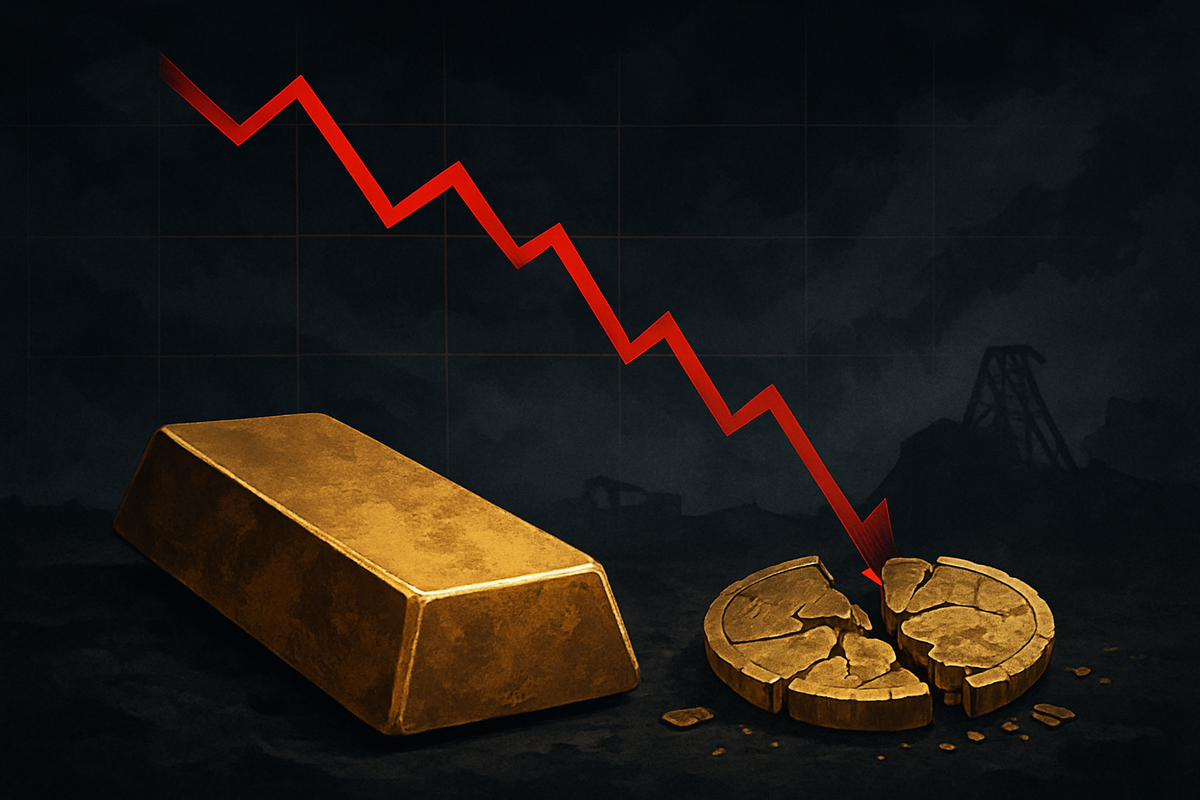
Johannesburg, South Africa – Shares of leading South African gold producer Harmony Gold (JSE: HAR) (NYSE: HMY) have experienced a dramatic decline this week, plummeting amidst a historic and significant drop in global gold prices. The sell-off has wiped billions from the company's market capitalization, sending shockwaves through the mining sector and raising concerns about the immediate future of gold-focused equities. While Harmony Gold has made strategic moves to diversify its portfolio, the overwhelming pressure from a volatile gold market has overshadowed these efforts, leaving investors grappling with substantial losses.
The immediate implications are clear: a significant reduction in investor confidence in pure-play gold miners, a reassessment of commodity-dependent portfolios, and a stark reminder of the inherent risks associated with volatile global markets. This week's events serve as a critical indicator of how quickly market sentiment can shift, even for historically stable assets like gold.
Gold's Historic Tumble Drags Harmony Gold Down
The primary catalyst for Harmony Gold's (JSE: HAR) (NYSE: HMY) precipitous fall this week was a monumental drop in the global price of gold, particularly on Tuesday, October 21, 2025. On this day, front-month Comex gold for October delivery shed an astonishing $248.70 per ounce, a 5.7% decline that marked its largest one-day dollar loss on record and its steepest percentage fall since June 20, 2013. This unprecedented plunge in the underlying commodity directly translated into a severe blow for gold producers.
Several factors converged to trigger this historic gold sell-off. Easing geopolitical tensions, particularly between the U.S. and China, reduced gold's appeal as a safe-haven asset. After a period of surging prices that saw gold breach $4,000 per ounce earlier in October, investors engaged in significant profit-taking. Compounding the issue was reduced market liquidity, largely attributed to the absence of the Indian market due to the Diwali festival. Earlier in the week, on October 17, aggressive bets on interest rate cuts by the Federal Reserve and persistent global trade tensions had already set a negative tone for the precious metal.
Harmony Gold's shares bore the brunt of this market upheaval. From the close of Friday, October 17, through Wednesday, October 23, shares of Harmony Gold (NYSE: HMY) were down 10.5%. On the critical day of Tuesday, October 21, the stock tumbled by 10.99%, gapping down significantly at the open. On the Johannesburg Stock Exchange, Harmony Gold (JSE: HAR) closed on Wednesday, October 22, at 301.52 ZAR per share, a 5.3% drop from the prior day and a continuation of a downward trend that saw the stock fall 14.06% compared to the previous week's close.
Adding to the complexity, concerns about Harmony Gold's operational costs and capital expenditure had already been weighing on investor sentiment. In late August 2025, the company's shares plunged after it warned of a projected 9-16% increase in costs for the fiscal year starting July 1, 2025, alongside an expected R13 billion in capital expenditure. These pre-existing profitability concerns, coupled with a 5% decline in gold production for fiscal year 2025 due to adverse weather and safety stoppages, made the stock particularly vulnerable to the recent gold price shock. Despite two strategically positive announcements on October 24, 2025 – the finalization of the US$1.01 billion MAC Copper acquisition and the release of strong FY25 annual reports – the overwhelming negative pressure from the gold market ensured these positive developments were largely overshadowed.
Shifting Fortunes in the Mining Sector
The dramatic decline in gold prices and, consequently, in the shares of companies like Harmony Gold (JSE: HAR) (NYSE: HMY) creates clear winners and losers across the financial markets and the broader mining sector. Pure-play gold mining companies, especially those with higher operational costs or significant debt, are undoubtedly the primary losers. Their revenue and profit margins are directly tied to the price of gold, meaning any sustained downturn will severely impact their profitability, investment in new projects, and even their ability to sustain dividends. Other prominent gold miners globally will face similar pressures, potentially leading to widespread share price depreciation across the sub-sector.
Conversely, diversified mining companies, particularly those with strong exposure to other commodities like copper, lithium, or iron ore, may emerge relatively unscathed or even benefit from a reallocation of investor capital. Harmony Gold's recent acquisition of MAC Copper, owner of the CSA copper mine in Australia, is a strategic move to mitigate its gold-only risk, signaling a broader industry trend towards diversification. Companies heavily invested in industrial metals, which are often driven by economic growth rather than safe-haven demand, might see increased investor interest. Furthermore, short-sellers who correctly anticipated the gold market's correction would have reaped significant profits, while investors holding cash or looking for undervalued assets in other sectors might find new opportunities. The event also highlights the potential for increased merger and acquisition activity in the gold sector, as stronger players might look to acquire distressed assets at lower valuations.
Broader Implications for Global Markets
This week's events extend beyond the immediate financial performance of gold miners, signaling broader shifts in global market dynamics and investor sentiment. The sudden retreat from gold as a safe-haven asset reflects an easing of certain geopolitical anxieties, particularly between the U.S. and China, suggesting a potential thaw in trade relations or a perceived reduction in global instability. This could have ripple effects across various markets, potentially boosting risk appetite for growth-oriented assets and sectors. However, the sheer volatility also underscores the fragility of market stability, reminding investors that underlying economic or political shifts can trigger rapid re-pricings of even traditionally stable assets.
The event fits into a broader trend of increased commodity market volatility, influenced by macroeconomic factors like interest rate expectations, inflation concerns, and supply chain disruptions. For the mining industry, it reinforces the imperative for diversification and cost efficiency. Companies with high operating costs or those overly reliant on a single commodity will face intensified pressure. Regulatory and policy implications could also arise, especially in gold-producing nations like South Africa, where a struggling mining sector can have significant socio-economic consequences. Governments might consider interventions or support mechanisms to protect jobs and economic stability, though such measures often come with their own set of challenges. Historically, periods of sharp commodity price corrections have often led to consolidation within the industry and a re-evaluation of long-term investment strategies, a pattern that may well repeat itself.
The Path Forward: Volatility and Strategic Shifts
Looking ahead, the short-term outlook for Harmony Gold (JSE: HAR) (NYSE: HMY) and the broader gold mining sector remains one of heightened volatility and uncertainty. Investors should brace for continued price swings as the market digests the implications of the gold price correction and reacts to new economic data and geopolitical developments. A sustained recovery in gold prices would be crucial for the sector's rebound, but this hinges on factors like future inflation expectations, interest rate policies of major central banks, and the re-emergence of global uncertainties that typically boost safe-haven demand. In the absence of such a recovery, further downward pressure on share prices and profitability for gold miners is likely.
In the long term, strategic pivots, such as Harmony Gold's diversification into copper through the MAC Copper acquisition, are likely to become more prevalent across the mining industry. This move positions Harmony Gold to potentially benefit from the growing demand for industrial metals driven by the global energy transition. However, the successful integration of new assets and the realization of diversification benefits will take time and present their own set of challenges. Market opportunities may emerge for contrarian investors looking to acquire undervalued gold assets if prices stabilize, or for those focusing on companies with robust balance sheets and diversified portfolios. The challenges, however, will be significant for high-cost producers and those with limited financial flexibility. Potential scenarios range from a swift recovery in gold prices if geopolitical tensions escalate again, to a prolonged period of subdued prices leading to industry consolidation and project deferrals.
A Turbulent Week and the Road Ahead
This past week has been a turbulent one for Harmony Gold (JSE: HAR) (NYSE: HMY) and the gold market, with the historic plummet in gold prices serving as the undeniable primary driver of the company's share price decline. While Harmony Gold's operational challenges and strategic diversification efforts played secondary roles, they either exacerbated the downward trend or proved insufficient to counteract the overwhelming market forces. The key takeaway is the profound sensitivity of gold miners to commodity price fluctuations, highlighting the inherent risks in single-commodity exposure.
Moving forward, the market will remain highly attentive to global economic indicators, central bank policies, and geopolitical developments, all of which will influence the trajectory of gold prices. Investors in Harmony Gold should closely monitor the integration progress of the MAC Copper acquisition, as its success will be crucial for the company's long-term resilience and its ability to transform into a more diversified, less gold-dependent entity. Future earnings reports will also be critical in assessing how the company manages its costs and capital expenditure in a challenging market. The lasting impact of this week's events will likely be a renewed focus on diversification, cost efficiency, and robust risk management strategies across the entire precious metals mining sector.
This content is intended for informational purposes only and is not financial advice







